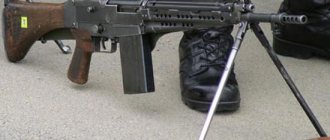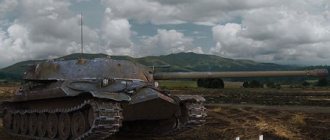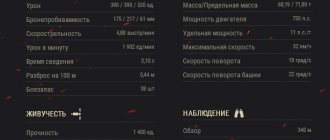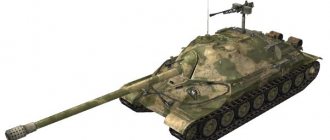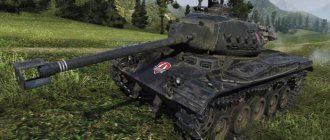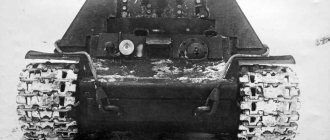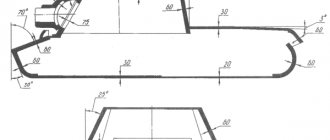TTX SU-100Y
So, the first thing I would like to focus your attention on is that we were given an increased safety margin, because 700 HP for a sixth-level tank destroyer is a very good indicator. At the same time, the review leaves much to be desired.
Regarding survivability parameters, the SU-100Y has weak armor characteristics. Even our classmates easily penetrate us into the frontal projection, and despite the fact that this machine does not have a preferential level of combat, you will have to fight against eights. Weak armor is aggravated by large dimensions, so you need to play very carefully.
There is no big breakthrough in terms of mobility. The SU-100Y WoT tank destroyer is slow, it does not have a high maximum speed, due to the not very pleasant ratio of weight to engine power, we are not rich in dynamics, and maneuverability is not the best.
gun
Now let's talk about weapons and here things are a little better. The main advantage of this unit is its large alphastrike. But you have to pay for a powerful shot, so the SU-100Y gun takes quite a long time to reload, but the DPM still remains decent.
Fortunately, we were also given high levels of armor penetration, and even when you get into battles at the eighth levels, you will not feel vulnerable. There is one more advantage to this - we practically do not need gold, thanks to which the SU-100Y tank farms quite well.
If you look at the accuracy, our accuracy is average. The spread is not the largest, but also quite large, with mixing the picture is the same and only the stabilization has gone wrong, however, this is not surprising.
The really weak parameters of the SU-100Y World of Tanks are the vertical and horizontal aiming angles. You can see the numbers in the screenshot and I assure you that playing is quite uncomfortable, although you can get used to everything.
Self-propelled guns under the "Y" sign
The designers of Plant No. 185 tried their best to simplify the design of the new tank in order to reduce its production time as much as possible, and, in the end, decided to abandon the movable turret and make a simpler fixed wheelhouse. Soon the number of changes made to the design reached a critical number, and they decided to replace the index of the resulting vehicle with T- 100 Y. When it finally became clear that the Leningraders had an assault self-propelled gun instead of an artillery tank, it was renamed SU-100 Y
The combat experience gained by Soviet tank crews during the Spanish Civil War of 1936–39 had a huge impact on the development of tank building in the USSR. First of all, it became clear that bulletproof armor less than 30 mm thick no longer meets the requirements of modern combat, and therefore the Red Army needs tanks with armor capable of withstanding hits from 37–45 mm shells. In the main tank-building centers of the USSR (Leningrad and Kharkov), work began to increase the armor of existing tanks and create new ones with ballistic armor protection.
Armor for the Red Army
By a Government Decree of July 25, 1937, the design bureau of the Kharkov Comintern Locomotive Plant No. 183 (hereinafter referred to as Plant No. 183) was obliged to increase the armor of the heavy five-turret T-35 breakthrough tanks that it produced. The resolution was implemented through the joint efforts of Kharkov residents and designers of the Leningrad Experimental Mechanical Engineering Plant named after S. M. Kirov No. 185 (hereinafter referred to as Plant No. 185), who, in fact, developed this tank. The frontal armor of the T-35 increased to 60 mm, the side armor - to 40-45 mm (for the turrets - up to 40-55), but there was no reserve left for a further increase in the mass of the tank - the chassis of the vehicle, as well as its power plant, were already barely withstand increased loads. It became obvious that the Red Army needed a completely new breakthrough tank.
On November 5, 1937, the Armored Directorate of the Red Army (hereinafter referred to as ABTU) approved the parameters for a new heavy tank, which was supposed to replace the T-35 in the army. Initially, the development of the new vehicle was entrusted to plant No. 183, but the design corps of the enterprise was bled dry by repression, its design bureaus could not even cope with the design of new modifications of the BT light tank, and the development of a much more complex “heavy” project was out of the question.
Modernized T-35 tanks with reinforced armor and a conical turret at the parade on November 7, 1940 in Moscow. At that time they were already hopelessly outdated Source – waralbum.ru
In April 1938, the Main Military Council was held in Moscow, where they decided to develop at the Leningrad Kirov Plant (hereinafter referred to as LKZ) and Plant No. 185 a project for a new heavy three-turret breakthrough tank with projectile-proof armor, a 76-mm assault gun in the main turret and 45 -mm guns - in the other two. In May of the same year, the chief designers of both enterprises were informed of the tactical and technical requirements (hereinafter referred to as TTT) that were presented to the vehicle.
At LKZ, experienced managers (plant director I.M. Zaltsman and chief designer Zh.Ya. Kotin) launched the QMS project, named after the recently deceased party leader Sergei Mironovich Kirov. At plant No. 185, simpler managers worked, and the development was called casually - “Object 100”. The general management of the work on it was carried out by the chief designer of the enterprise, S. A. Ginzburg, and E. Sh. Paley was appointed lead designer for the project. Until August, when design contracts were concluded with factories, designers carried out mainly preliminary work. However, on August 7, 1938, a resolution of the Council of People's Commissars of the USSR No. 198ss was issued, according to which the SMK tank was required to be manufactured by May 1, and the “Object 100” by June 1, 1939. On October 10 and 11, the ABTU commission, chaired by military engineer 1st rank Korobkov, reviewed the drawings and full-size wooden models of the vehicles. Both design groups did not use spring-type suspension, as indicated in the TTT: it was planned to install torsion bars on the SMK, and balance beams with leaf springs on the Object 100. However, this did not bother the commission, and it gave permission to start work on assembling prototypes in metal.
On December 9, 1938, both projects were considered at a joint meeting of the Politburo of the Central Committee of the All-Union Communist Party of Bolsheviks and the USSR Defense Committee. As a result of the debate, the layout of the competition machine was changed, removing one of the towers. Researcher D.S. Ibragimov in his book “Confrontation” claims that Stalin personally removed the turret from the model with the words: “There is nothing to be done from the Muir and Meriliz tank!”
[The leader used this expression when talking about something overly complicated.
(“Mur and Meriliz” is the pre-revolutionary name of one of the Moscow department stores) - approx. author] How much did I remove?”
–
“Three tons”
–
“Use them to enhance armor protection
.
Work began to boil with renewed vigor, and already in January 1939, the sale of tanks in metal began. The armor for the “Object 100” was manufactured by the Izhora plant, the transmission by the Kharkov plant No. 183, most of the remaining units by plant No. 185 (the general assembly of the vehicle was also carried out there). On July 1, 1939, plant testers made a test drive on the new vehicle, and on July 31, the tank was completely ready for factory and field tests.
T-100 tank, the chassis of which served as the basis for the T-100Y Source – modelist-konstruktor.com
However, during test runs, breakdowns followed one after another, so the designers did not have time to prepare the tank for the government show scheduled for September 20, 1939. The servo control of the main clutch pedals failed, so it had to be removed and sent for modification to Kharkov, to plant No. 183. And there, in connection with the work on the experimental tanks A-20 and A-32 (the future T-34), which were also hastily preparing for the September show, there was a lot to do. The Kharkovites decided that it would be better if the Leningraders didn’t make it in time than they did. Fortunately, no one was punished for the lack of availability of the T-100 tank on time (this designation was given to “Object 100” after production). The servo control was redone, management was informed about this, and the machine continued to carry out the test program.
The progenitor of the future self-propelled gun
What was the T-100 tank like? The total weight of the vehicle reached 58 tons, and its body received 60 mm thick anti-ballistic armor along its entire perimeter. The upper frontal part had a curved shape, as well as an inclination angle of 75° in its lower part, and 25° in the upper part. The lower frontal part was positioned at an angle of 40°. The bottom armor was combined: 30 mm in the front part of the hull (to withstand the effects of mines) and 20 mm in the rear. The thickness of the hull roof was 20 mm. The fastening of the sheets to the frame was carried out in a rather original way - they were fastened with goujons, after which the seams were welded.
T-100 tank chassis armor scheme Source – modelist-konstruktor.com
The layout of the T-100 was classic, with the engine and transmission located in the rear compartment. As a power plant, both SMK and T-100 received the GAM-34-BT engine (Alexander Mikulin’s skimmer in an armored version), created on the basis of the four-stroke twelve-cylinder aircraft AM-34. Its power is 850 hp. With. at 1800 rpm it was enough to accelerate a heavy 58-ton tank to 35.7 km/h on the highway, and up to 10.3 km/h over rough terrain. To service the engine and transmission, special hatches were cut into the roof of the engine compartment and the rear of the tank, covered with armored covers. The power plant was started using compressed air or an ST-70 electric starter with a power of 15 hp. With. The electrical equipment of the vehicle was made according to a single-wire circuit, the on-board voltage was 12 and 24 V and was provided by four 6STE-144 batteries, which were connected in series to a DC generator with a power of 2.5–3 kW. The generator was installed on the gearbox (hereinafter referred to as the gearbox) and was driven by the gear of the engine cooling fan. Aviation gasoline was used as fuel, which was placed in four internal aluminum tanks with a total capacity of 1160 liters, which, when driving on a highway, allowed a travel distance of 210 kilometers.
The transmission consisted of a five-speed three-way gearbox with five forward speeds and one reverse, a three-disc main dry friction clutch (steel on ferodo), two multi-disc dry friction side clutches (steel on steel with band brakes lined with ferodo) and two simple single-row final drives.
A bladed axial fan, which was installed horizontally on the gearbox, was responsible for cooling the engine and transmission compartment. Air intake occurred through side openings, which were located in the front of the fan and covered with fine mesh. The hot exhaust air was discharged through the rear of the engine compartment to the upper section of the tracks.
Comfort in driving the car for the driver was ensured by the use of a servo drive, which made it possible to reduce the effort on the turning levers to 10 kg, and on the pedals to 15 kg. If the servo drive failed, the required force on the turning lever increased to 80 kg - in other words, the tanker would have to lean on it with his whole body and make great efforts to force the tank to simply turn. An important element of comfort was the escape hatch, located in the bottom of the tank behind the driver’s seat. It was also possible to enter the tank through the turret hatches and the driver's hatch, located in the roof of the control compartment on its right side.
The chassis of the tank consisted of sixteen gable rubber-coated road wheels with a diameter of 730 mm (eight on each side) and ten support rollers (five per side). The drive was carried out on the rear wheels, equipped with removable ring gears. Fine-link caterpillar tracks with a width of 730 mm were assembled from one hundred and nine stamped tracks with an open metal hinge. The tank had a balanced suspension with leaf springs.
Testing of the vehicle continued, and the T-100 already had 1,000 km of mileage when war broke out between the USSR and Finland on November 30, 1939. The SMK, T-100, as well as the new experimental KV tank were included in a special company of experimental tanks and sent to the Karelian Isthmus - the Soviet command intended to test these vehicles in battle, using them in the assault on the fortifications of the Mannerheim Line. The company's actions were not entirely successful. On the third day of fighting (December 17, 1939), while advancing along the no-man's land, the SMK tank ran into a pile of boxes and exploded on a mine that was hidden underneath them. The crews of the T-100 and KV had to cover the exploded tank with fire and the hulls of their vehicles for several hours, while the tank crews tried to tow it to the rear. However, this was not possible, and as a result, Soviet tank crews had to dismantle everything possible from the SMK, and then transfer its crew to the T-100 and leave no man's land. During this operation, the T-100 tank received seven hits from enemy shells, but none of them could harm it. True, what the enemy could not do was achieved by the imperfect design of the tank - when moving to the rear, the magneto failed. And although the crew was able to get to their destination even with such a breakdown, the car still had to be sent to the factory for repairs.
Anti-drainage armored vehicles of Stalin
The fighting of the Finnish War showed that the prototypes of Soviet breakthrough tanks had insufficient gun power to cope with enemy bunkers. In this regard, in January 1940, the designers of LKZ and plant No. 185 received an order from the Deputy People's Commissar of Defense, 1st Rank Army Commander G.I. Kulik to install the 152-mm M-10 howitzer on their KV and T-100 tanks. In addition, at the end of 1939, the head of the ABTU, corps commander D. G. Pavlov, suggested that the designers install naval guns on the larger T-100 chassis: a 130-mm B-13-IIs cannon and a 203-mm B-4 howitzer. In addition, S. A. Ginzburg was instructed to develop, based on the T-100 tank, an engineering multifunctional armored tank-tractor, which could be used both as a tow truck for damaged armored vehicles and as a bridge laying vehicle. Plant No. 185 set to work with enthusiasm, resulting in several preliminary designs:
- T-100-Z tank with a 152-mm M-10 howitzer in the turret, which was developed specifically for it. Commander Kulik set the deadline for the preparation of this project until February 5, 1940;
- T-100-X tank with a 130-mm B-13-IIs naval gun in a wedge-shaped turret. The deadline for preparing the project was February 20;
- heavy artillery support tank T-100-V, armed with a 203 mm B-4 howitzer in a rotating turret. The designers asked to be released from this project.
However, it soon became clear that the capabilities of plant No. 185 did not allow such a large number of projects to be carried out simultaneously, therefore, with the permission of ABTU, the enterprise was also released from the engineering tank project. Since work on the creation of this tank had progressed the furthest, the plant decided to use its chassis to create self-propelled guns (the hull was manufactured by the Izhora plant, and the chassis with suspension was assembled at LKZ). The designers of Plant No. 185 tried their best to simplify the design of the new tank in order to reduce its production time as much as possible, and in the end they decided to abandon the movable turret and make a simpler fixed wheelhouse (this decision also made the vehicle lighter). Soon the number of changes made to the design reached a critical number, and they decided to replace the index of the resulting vehicle with the T-100Y. When it finally became clear that the Leningraders had an assault self-propelled gun instead of an artillery tank, it was renamed SU-100Y.
SU-100Y on display at the museum in Kubinka Source – zh.wikipedia.org
The chassis of the new self-propelled gun differed from the T-100 only in the torsion bar suspension, which, according to the TTT, should have been equipped with the canceled engineering tank. Instead of towers, a high vertical wedge-shaped conning tower was installed on the roof of the vehicle, in which a 130-mm B-13-IIc naval gun of the 1929 model was placed on a special pedestal (in the USSR, cruisers and coastal batteries were equipped with it). Thanks to the 55-caliber barrel, the projectile speed near the muzzle of the gun reached 870 m/s. Despite the fact that the B-13-IIc's pointing angles were very modest (from -2° to +15° vertically, and ±6° horizontally), it had a high range. In addition, for an artillery system of this class, the gun had a respectable rate of fire - 7-8 rounds per minute (such high rates were achieved by using a push-pull piston bolt and a spring rammer). Aiming was carried out using a Hertz panorama.
The self-propelled gun's ammunition consisted of thirty 130-mm concrete-piercing and high-explosive fragmentation shells and powder charges for them (the weight of one shell reached 36 kg). To fire at maximum speed, the self-propelled gun required two loaders. In addition to them, the crew included a commander, driver, gunner and mechanic. The total crew size was six people, although it is quite possible that a seventh was planned - a gunner-radio operator. In addition to the cannon, the vehicle was armed with three 7.62-mm DT machine guns, the total ammunition for which was 1,890 rounds. Machine guns were installed on the stern and on the sides of the self-propelled gun.
SU-100Y, front view Source – tehnikapobedy.ru
For external communication, a 71-TK-3 radio station with a whip antenna was used, and inside the vehicle the tankers communicated using a special TPU-6 device.
Suspension of the SU-100Y (starboard side, rear view) Source – bemil.chosun.com
Unclaimed development
The self-propelled gun hull was produced quite quickly - already on February 24, 1940 (that is, almost two months after the start of design) it entered the assembly shop of plant No. 185. The final assembly of the car began on March 1 and progressed at an accelerated pace. Finally, on March 14, the self-propelled gun was ready, but the war with Finland had ended the day before, and it was not possible to test the SU-100Y in combat conditions. Meanwhile, for plant No. 185 the situation was unfavorable - instead of their “product” T-100, the KV-1 produced by LKZ won in the competition for a breakthrough tank, and KV-2 “left behind” all other projects (T-100X and SU- 100Y).
The company tried to rectify the situation and proposed developing the “Object 103” - a heavy coastal defense tank with a 130-mm B-13-IIs cannon in a rotating turret (it was decided to abandon the second turret with a 45-mm cannon). The factory even managed to assemble a full-size wooden model and a turret with weapons in it, but the military soon abandoned this project as well. As a result, plant No. 185 was merged with another Leningrad enterprise - plant No. 174.
As for the SU-100Y self-propelled gun, in the summer of 1940 it was sent to a test site in Kubinka, where it remained until October 1941, when German troops approached Moscow. The vehicle was included in the Separate Special Purpose Heavy Division along with two more unclaimed creations of Plant No. 185 - the SU-14-Br-2 self-propelled guns. The author does not have details about the participation of this unit in the Battle of Moscow.
SU-100Y (left) and its “girlfriend” in the Separate Heavy Division – SU-14-Br-2 (right) Source – comgun.ru
Unlike the T-100 tank, traces of which were lost somewhere in Chelyabinsk, where it was evacuated from the Moscow region, the SU-100Y has survived to this day. Today it is exhibited at the Military Historical Museum of Armored Weapons and Equipment in Kubinka next to one of the “girlfriends” in the division - the SU-14-Br-2 self-propelled gun.
SU-100Y in the game World of Tanks Source – wiki.wargaming.net
Equipment for SU-100Y
As for the selection and installation of additional modules, in our case priority is given to increasing the rate of fire and increasing the aiming speed, but with the third point everything is not so clear, there may be options. Based on this, the equipment for the SU-100Y is selected as follows: 1. – the same increase in rate of fire that our DPM will significantly increase. 2. – the best choice for faster mixing. 3. – a comprehensive performance boost that increases several important parameters at once.
Now let's talk about an alternative to the third point. We have a weak view and if you put , the creature will not help the matter, so you can choose , in this case it becomes possible to play from your own light.
Characteristics
The self-propelled gun was intended for a crew of six people: a commander, two gunners, two loaders and a driver. The total weight of the vehicle was 64 tons. Such a significant weight was concentrated in relatively small overall dimensions: the length of the SU-100Y was 10.9 m, width - 3.4 m. Sheets of armor 60 mm thick covered the forehead and sides of the self-propelled gun, the roof and rear were less protected. The gasoline engine allowed the SU-100Y to move quite quickly across the terrain - the vehicle's highway speed reached 32 km/h, and on the ground - 12 km/h. The car could travel about 120 km in one refueling.
Tactics for playing the SU-100Y
In order to play effectively on this unit, deal a lot of damage and take away the scalps of defeated opponents, you should understand that our main strength is weapons, while armor combined with large dimensions and poor mobility will make itself felt.
Thus, on the SU-100Y, combat tactics are to stick to the second line. You must take an advantageous position from where you can open a good shot at the enemy, but it will be difficult to expose you.
In such realities, standing behind the bushes, the Soviet tank destroyer SU-100Y plays very advantageously from its large alpha strike. We take a shot and immediately roll back to reduce the likelihood of getting caught in the light.
By the way, when taking a position, do not forget to think about your limited vertical aiming angles, so it will not always be possible to stand on a hill. Otherwise, the SU-100Y World of Tanks tank is truly a formidable machine, it is capable of farming well even in battles at the bottom of the list, but it is worth remembering that you cannot let the enemy get close to you, and artillery also likes to shoot at our barn and it is dangerous to stand in one place throughout the battle , it is necessary to change positions.
History of the creation of the SU-100U
Even during the Winter War, the Red Army felt an urgent need for armored engineering vehicles. In 1939, it was decided to create an engineering tank based on the T-100 with anti-ballistic armor to transport explosives and sappers, build a bridge, evacuate damaged tanks and perform other similar tasks.
During the design process, an order was received - a cannon was required to be installed at the T-100 base in order to fight enemy fortifications. As a result, the plant was asked to change plans, that is, to start designing not an engineering vehicle, but an self-propelled gun. Permission was received, and in January 1940, the drawings of the T-100-X, a prototype of the SU-100-Y, were transferred to the Izhora plant.
During the production of the machine, the wheelhouse was replaced with a simpler one to speed up assembly, and by March 1940, the SU-100-Y or T-100-Y, as it was also called, went on its first trip.

